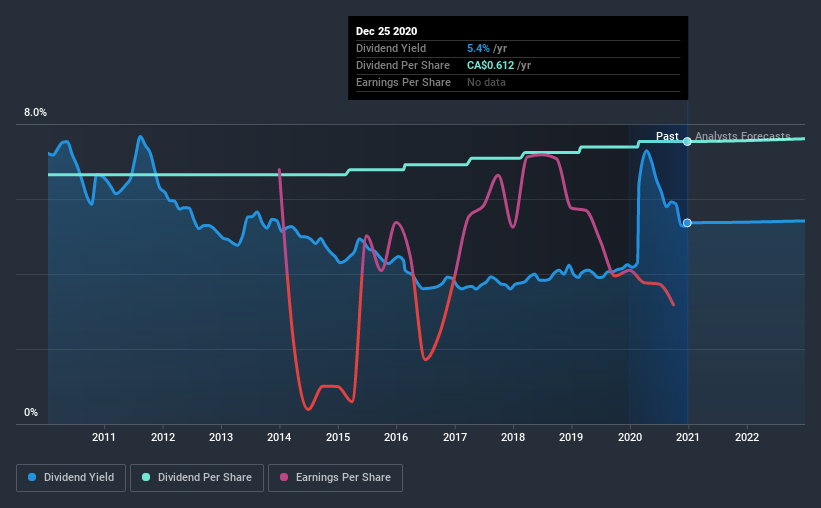We Wouldn't Be Too Quick To Buy Chartwell Retirement Residences (TSE:CSH.UN) Before It Goes Ex-Dividend
Chartwell Retirement Residences (TSE:CSH.UN) stock is about to trade ex-dividend in three days. You can purchase shares before the 30th of December in order to receive the dividend, which the company will pay on the 15th of January.
Chartwell Retirement Residences's next dividend payment will be CA$0.051 per share. Last year, in total, the company distributed CA$0.61 to shareholders. Last year's total dividend payments show that Chartwell Retirement Residences has a trailing yield of 5.4% on the current share price of CA$11.41. Dividends are a major contributor to investment returns for long term holders, but only if the dividend continues to be paid. So we need to check whether the dividend payments are covered, and if earnings are growing.
See our latest analysis for Chartwell Retirement Residences
If a company pays out more in dividends than it earned, then the dividend might become unsustainable - hardly an ideal situation. Chartwell Retirement Residences paid a dividend last year despite being unprofitable. This might be a one-off event, but it's not a sustainable state of affairs in the long run. Given that the company reported a loss last year, we now need to see if it generated enough free cash flow to fund the dividend. If Chartwell Retirement Residences didn't generate enough cash to pay the dividend, then it must have either paid from cash in the bank or by borrowing money, neither of which is sustainable in the long term. It paid out more than half (60%) of its free cash flow in the past year, which is within an average range for most companies.
Click here to see the company's payout ratio, plus analyst estimates of its future dividends.
Have Earnings And Dividends Been Growing?
Companies that aren't growing their earnings can still be valuable, but it is even more important to assess the sustainability of the dividend if it looks like the company will struggle to grow. Investors love dividends, so if earnings fall and the dividend is reduced, expect a stock to be sold off heavily at the same time. Chartwell Retirement Residences reported a loss last year, but at least the general trend suggests its income has been improving over the past five years. Even so, an unprofitable company whose business does not quickly recover is usually not a good candidate for dividend investors.
The main way most investors will assess a company's dividend prospects is by checking the historical rate of dividend growth. In the past 10 years, Chartwell Retirement Residences has increased its dividend at approximately 1.3% a year on average.
We update our analysis on Chartwell Retirement Residences every 24 hours, so you can always get the latest insights on its financial health, here.
Final Takeaway
Is Chartwell Retirement Residences worth buying for its dividend? It's hard to get used to Chartwell Retirement Residences paying a dividend despite reporting a loss over the past year. At least the dividend was covered by free cash flow, however. Bottom line: Chartwell Retirement Residences has some unfortunate characteristics that we think could lead to sub-optimal outcomes for dividend investors.
Although, if you're still interested in Chartwell Retirement Residences and want to know more, you'll find it very useful to know what risks this stock faces. To help with this, we've discovered 2 warning signs for Chartwell Retirement Residences (1 can't be ignored!) that you ought to be aware of before buying the shares.
We wouldn't recommend just buying the first dividend stock you see, though. Here's a list of interesting dividend stocks with a greater than 2% yield and an upcoming dividend.
This article by Simply Wall St is general in nature. It does not constitute a recommendation to buy or sell any stock, and does not take account of your objectives, or your financial situation. We aim to bring you long-term focused analysis driven by fundamental data. Note that our analysis may not factor in the latest price-sensitive company announcements or qualitative material. Simply Wall St has no position in any stocks mentioned.
Have feedback on this article? Concerned about the content? Get in touch with us directly. Alternatively, email editorial-team (at) simplywallst.com.

 Yahoo Finance
Yahoo Finance 
